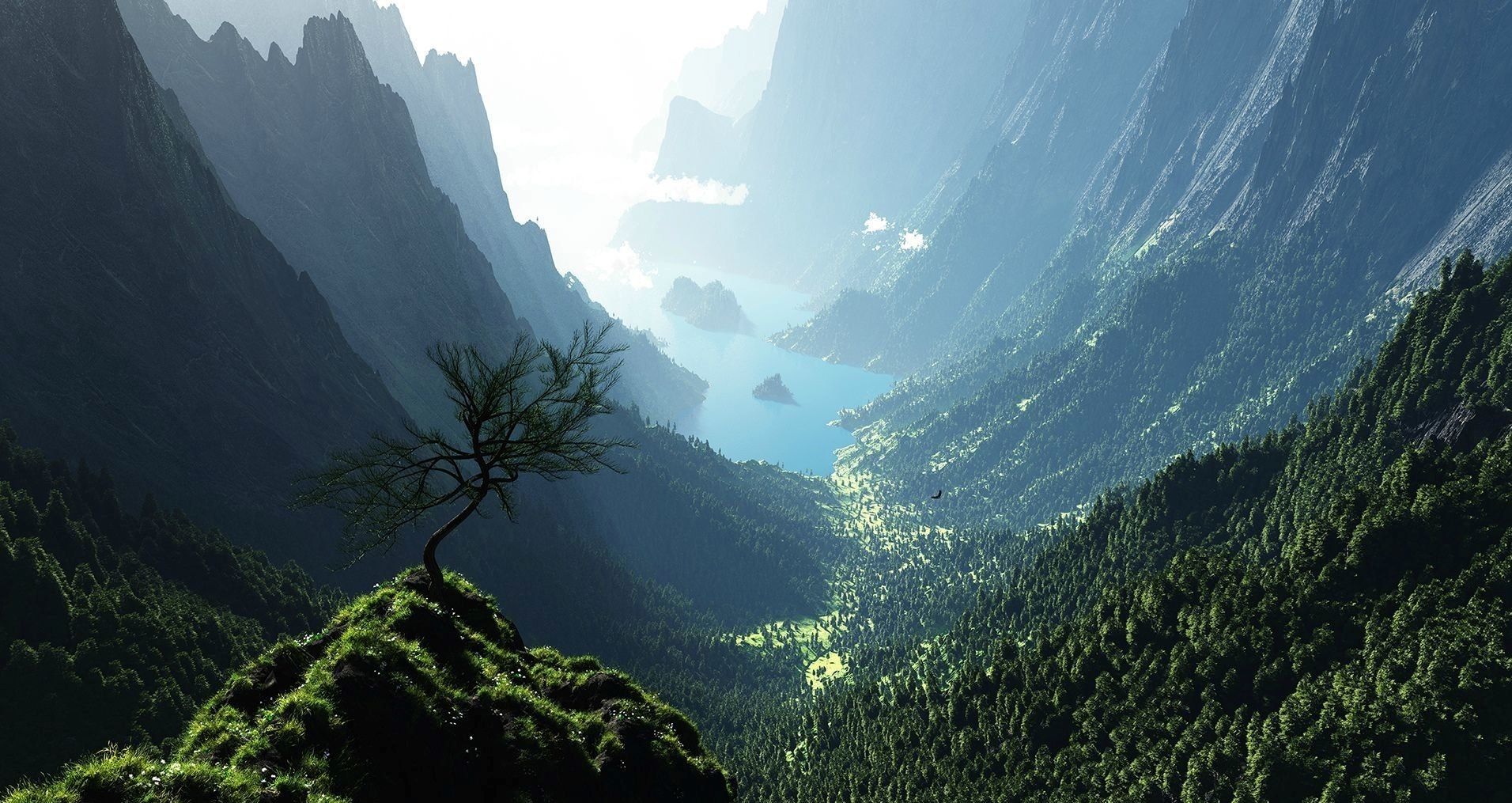
Valleys are captivating and diverse landscapes that can be found all around the world. From towering mountain valleys to lush green meadows, they showcase the incredible beauty and wonder of nature. Valleys are formed through various geological processes, and they offer a unique habitat for a wide range of plant and animal species.In this article, we will explore 17 fascinating facts about valleys that will enhance your understanding and appreciation of these natural wonders. We will delve into the formation of valleys, their different types, and the ecological significance they hold. From the stunning beauty of the Grand Canyon to the hidden valleys tucked away in the remote corners of the world, join us on a journey to discover the awe-inspiring secrets of valleys.So, let’s get started and uncover the wonders that lie within these breathtaking landscapes!
Key Takeaways:
- Valleys are diverse and fertile landscapes formed by natural forces, providing homes to various plants and animals. They also offer recreational activities and inspire art and literature.
- Human activities pose threats to valleys, making conservation efforts crucial. Valleys also hold cultural and spiritual significance in many societies, connecting people to their ancestral roots and the natural world.
Valley is a landform between two mountains.
A valley is a low-lying area of land, often located between two mountains or hills. It is formed by the natural erosion of water, glaciers, or tectonic forces over thousands or millions of years.
Valleys are often fertile and ideal for agriculture.
Due to the accumulation of sediment and the presence of rivers or streams, valleys tend to have rich soil, making them perfect for farming. Many civilizations throughout history have settled in valleys to take advantage of the fertile land.
Valleys can vary in size and shape.
Valleys come in a variety of forms, from narrow and steep-sided ravines to wide and flat floodplains. Their size and shape depend on the geological processes that shaped them, such as the type of rock, climate, and the strength of the forces at play.
The Grand Canyon is one of the most famous valleys in the world.
Located in Arizona, USA, the Grand Canyon is a magnificent example of a deep and expansive valley. Carved by the Colorado River, it showcases the power of erosion over millions of years.
Valleys can be formed by different processes.
The formation of valleys can be attributed to various factors, including tectonic activity, glacial erosion, volcanic activity, or even the simple flow of rivers and streams. Each process leaves a distinct mark on the landscape.
Yosemite Valley is a breathtaking example of glacially-formed valley.
Located in California, USA, Yosemite Valley was sculpted by glaciers during the last Ice Age. Its sheer cliffs, waterfalls, and lush forests make it a popular destination for nature enthusiasts.
Valleys are home to diverse ecosystems.
Due to the varied topography and microclimates within valleys, they support a wide array of plant and animal species. Valleys often serve as natural corridors for wildlife, allowing for movement and migration.
The Nile Valley is often referred to as the cradle of civilization.
The Nile Valley, located in Egypt, has been the birthplace of one of the earliest human civilizations. The fertile soil and reliable water source provided by the Nile River supported the development of agriculture and led to the rise of the ancient Egyptian empire.
Valleys can have unique weather patterns.
The shape and orientation of a valley can influence local weather conditions. Valleys tend to trap air, resulting in temperature inversions or the formation of microclimates. This can lead to variations in temperature and precipitation within a relatively small area.
The Silicon Valley is known as the hub of the tech industry.
Situated in California, USA, Silicon Valley is renowned for being the epicenter of technological innovation. It is home to numerous high-tech companies, startups, and venture capitalists shaping the future of the digital world.
Many famous national parks are located in valleys.
Valleys often provide the perfect setting for national parks, showcasing the beauty and diversity of nature. Examples include Death Valley National Park, Shenandoah National Park, and Yellowstone National Park.
Valleys can offer breathtaking views and recreational opportunities.
Valleys with their picturesque landscapes and serene surroundings are magnets for outdoor enthusiasts. Hiking, camping, rock climbing, and photography are just a few of the activities that can be enjoyed in these natural wonders.
Valleys play a crucial role in the water cycle.
As water flows from higher elevations towards lower elevations, it collects in valleys, forming rivers, lakes, and wetlands. Valleys act as natural reservoirs, storing and distributing water to support ecosystems and provide drinking water to nearby communities.
The Great Rift Valley is the largest rift valley on Earth.
Stretching over 6,000 kilometers through Africa, the Great Rift Valley is a geological marvel. It is home to diverse wildlife, stunning landscapes, and has played a significant role in human evolution.
Valleys have inspired artists and writers for centuries.
The beauty and tranquility of valleys have served as a muse for countless painters, poets, and authors. From Romantic landscape paintings to epic poems, valleys have been celebrated for their innate charm and natural grandeur.
Some valleys are threatened by human activities.
Human encroachment, urbanization, deforestation, and pollution pose significant threats to the delicate ecosystems found in valleys. Conservation efforts are essential to preserve these invaluable natural resources for future generations.
Valleys can have spiritual and cultural significance.
In many cultures, valleys hold a special place in their mythology, folklore, and spiritual beliefs. They may be considered sacred or serve as pilgrimage sites, connecting people to their ancestral roots and the natural world.
These 17 facts about valleys, ranging from their geological formation to their cultural significance, provide a glimpse into the diverse and captivating world of these natural wonders. Whether you are an adventurer, a nature enthusiast, or simply someone who appreciates the beauty of the Earth, valleys offer a breathtaking range of experiences to explore and cherish.
Conclusion
The Valley is a unique and breathtaking natural wonder that captivates visitors from all over the world. With its stunning landscapes, rich biodiversity, and fascinating geological features, it stands as a testament to the beauty and power of nature.
From its towering mountains to its serene meadows and cascading waterfalls, the Valley offers a multitude of outdoor recreational activities and opportunities for exploration. Whether you’re an avid hiker, a nature photographer, or simply seeking a peaceful getaway, the Valley has something to offer everyone.
By immersing ourselves in nature and appreciating the wonders of the Valley, we can gain a deeper understanding of our connection to the natural world and the importance of preserving and protecting it for future generations.
So, pack your bags, lace up your hiking boots, and prepare to be amazed by the awe-inspiring beauty of the Valley. It’s a destination like no other, where nature’s magnificence takes center stage and leaves an indelible mark on our hearts and souls.
FAQs
1. What is the Valley?
The Valley refers to a geographic area characterized by its deep, elongated, and often steep-sided valleys formed by various natural processes such as erosion and glaciers.
2. Where can I find the Valley?
The Valley can be found in various parts of the world, including famous locations like Yosemite Valley in California, Wye Valley in Wales, and Kathmandu Valley in Nepal.
3. What activities can I enjoy in the Valley?
There are numerous activities you can enjoy in the Valley, such as hiking, camping, wildlife spotting, photography, fishing, and scenic drives. The possibilities are endless!
4. Is it safe to visit the Valley?
Visiting the Valley is generally safe as long as you adhere to the necessary precautions and guidelines. It’s essential to be aware of your surroundings, follow park rules, and take necessary measures to ensure your safety.
5. Can I visit the Valley year-round?
The accessibility and availability of activities in the Valley may vary depending on the season. It’s advisable to check the weather conditions and plan accordingly. Some activities, such as hiking, may require permits or have specific regulations during certain times of the year.
Was this page helpful?
Our commitment to delivering trustworthy and engaging content is at the heart of what we do. Each fact on our site is contributed by real users like you, bringing a wealth of diverse insights and information. To ensure the highest standards of accuracy and reliability, our dedicated editors meticulously review each submission. This process guarantees that the facts we share are not only fascinating but also credible. Trust in our commitment to quality and authenticity as you explore and learn with us.


